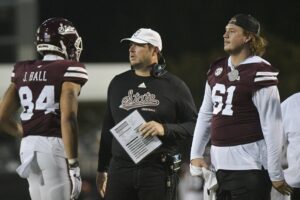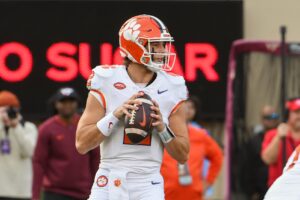NCAA Investigating Athlete Compensation
On September 30, California Governor Gavin Newsom signed into law the California Fair Pay to Play Act. The Act, California’s Senate Bill 206, made California the first state to mandate deep reforms over how college athletes are compensated for their efforts. We discussed that law here. The NCAA’s initial reaction was overwhelmingly negative. They called the law unconstitutional and derided it as an “existential threat” to college athletics. But on October 29, the NCAA announced that it would start investigating athlete compensation.
NCAA Board of Governors’ Press Release
Specifically, the NCAA Board of Governors “voted unanimously to permit students participating in athletics the opportunity to benefit from the use of their name, image and likeness,” according to an NCAA press release found here. Importantly—and this will become critical in a moment—the NCAA seeks to ensure that this benefit will occur “in a manner consistent with the collegiate model.” The Board directed “each of the NCAA’s three divisions to immediately consider updates to relevant bylaws and policies” according to defined principles and guidelines. The Board further “asked each division to create any new rules beginning immediately, but no later than January 2021.”
Ohio State University President and Chairman of the Board, Michael V. Drake, who has previously expressed support for the new California law, admits that the NCAA “must embrace change to provide the best possible experience for student athletes” while modernizing the future of college athletics. But while the vote certainly clears the way for student athletes to get compensation from any use of their likeness, the vote stops short of immediate implementation. And that’s an important point that many are not talking about yet.
Next Steps
While the NCAA press release reads that the Board asked the divisions to create new rules immediately, it also provides a hard deadline of January 2021 to enact those rules. The NCAA has not enacted any new rules yet. Indeed, the most important aspects of the NCAA’s press release are buried in the fine print. The Board specifically directed the NCAA’s divisions to consider updates that will ensure that NCAA-wide rules are implemented “in a manner consistent with the collegiate model.” In short, so far, the NCAA is merely investigating athlete compensation, not openly allowing it.
As a result, over the next several months, the conferences, the leadership from each division, and NCAA committees will each seriously investigate the path forward. The NCAA has given its framework within which those rules might work.
What Coaches Think About Athlete Compensation
And, so far, several college football coaches have expressed support. For example, our own Tony Siracusa asked UCLA Head Coach Chip Kelly whether he supported the plan. Kelly responded, “I think it is a benefit to the student-athletes.” He continued, “I think anything that is positive for the student athlete or is a benefit for the student athlete, I am 100% for it.”
Other coaches are not sold. Clemson Head Coach Dabo Swinney is on record in recent months saying that, with respect to paying players and “professionalizing college athletics, that’s where you lose me.” Swinney adds, “There’s enough entitlement in this world as it is.” And judging by social media reaction to the NCAA’s release, he is not alone in this thought, nor is Kelly in his.
Importantly, Kelly admits that he does not know how the rules will be implemented or what they will look like. “No one knows exactly what is going to go on,” he said. But he gets this part exactly right: “There has to be a well thought out plan that has to be implemented and until we get the details of what that plan is, I don’t know.” The NCAA has considered at least one idea that would mirror the Olympic model, and Kelly reminds fans, “I don’t think the Olympics got wrecked when those people had an opportunity to make money off of their name and image and likeness.”
How We Got Here
The move to this point has been a painfully slow one. But it has also been written on the wall for years. As we wrote last season when considering recent safety, stipend, and transfer rules, the landscape of college football—and college athletics as a whole—is changing rapidly. The NCAA, one will remember, was initially created simply to promote player safety. And to implement the forward pass.
With respect to its enforcement duties, however, the NCAA flexes remarkable inconsistency. Running jokes abound about how a flailing mid-major program will pay for the transgressions of the pay-for-play scheme that implicated Kansas’ basketball program. Unfortunately, those jokes resonate precisely because they find solid grounding in the truth. And let us avoid for the purposes of this article a full-fledged discussion about inconsistent—and downright illogical—rulings on waiver requests for transfers.
Based on that inconsistency and the NCAA’s stubborn inflexibility with regard to athlete compensation, former student athletes filed a lawsuit styled O’Bannon v. NCAA. In that lawsuit, former student-athletes directly challenged the NCAA’s use of former student athletes for commercial purposes. Famously—or, perhaps, infamously—this lawsuit led EA Sports to discontinue production of its widely-popular NCAA Football series. More seriously, however, the lawsuit ignited national debate over whether, and how, schools should compensate student athletes.
Even more recently, with some notable athletes—particularly high school basketball stars—electing to play a few years overseas under contract, the drive towards investigating athlete compensation might be seen as a way to save college athletics. The XFL, for example, has been signing college players who do not yet meet the age requirements of the NFL. And it might tread further into that territory if left unchecked.
California’s Shot
As noted above, California took an important first step towards making that conversation tangible. Fans and media, however, misquote and misunderstand the California law often. It does not require schools, or conferences, or the NCAA to pay players. In fact, it strictly prohibits the schools from being the conduits for the payments. Instead, it merely allows players to profit off of the use of their name, image, and likeness. It puts no cap on the level of compensation. But it also does not take effect until 2023.
This was never a law that California thought would stand in its entirety as passed. Instead, it was a gambit, an opening salvo. With stakes this big, the initial offer had to match, and California did just that. They passed a law that contains no limits to the ways players can profit or the amount they can profit. But they provided time, time for other states to pass similar litigation, time for the federal government to start discussing it, too. And it worked. The NCAA is sitting at the table now.
What The NCAA Will Investigate
Now that the NCAA has pulled up a chair, however, important questions remain—and lots of them.
Competitive Balance
How will this impact competitive balance between teams? For example, will schools in areas with numerous businesses and big money be able to attract more recruits based on greater marketing opportunities? No doubt that schools in small states with smaller resulting economies could have trouble keeping in a wide open system. West Virginia, Iowa, Iowa State, Nebraska, Kansas—those are just a handful of schools that could suffer. And teams like UCLA, USC, Miami, even Boston College, could benefit, just by being in such close proximity to major economic drivers that spend advertising dollars liberally.
Recruiting
How will this impact recruiting? And will teams actively recruit transfers using these same tools? Many cite Oregon as a prime example of this concern. Phil Knight could not only sponsor uniforms but sponsor player financial allocations. And the promise of such lucrative arrangements might provide further imbalance than we see now in the abilities of teams to draw blue chip talent.
Transfer Market
And about those transfers—what will this do to the transfer market? Will it open it up even further? Will overlooked players who work hard to develop over two or three years into surprise performers transfer to those lucrative markets? Or, to the contrary, will the companies sign college athletes to endorsement deals on the condition that they sign away their transfer rights?
Logistics
Then, there are logistical issues. Who exactly will be paying whom? Will advertisers ink deals directly with players? Will a new brand of college sports agents arise? Or perhaps advertisers will strike deals directly with the schools, and the school can choose to divide that money up among the athletes at the school’s discretion. When will the athletes earn their checks? Will schools or advertisers pay athletes up front or will athletes earn their checks at graduation?
Investigating Athlete Compensation Further
In short, there are a lot of questions. And the NCAA’s press release indicates that the NCAA will be looking very closely at how to balance these issues against the interest of fairness in how the money that student-athletes earn. Moreover, the NCAA will no doubt have to walk a fine line with Title IX if schools are dividing revenues unevenly between the sports.
We will examine each of these issues further in future parts of this series, as we explore the myriad of ways to answer these important questions.






